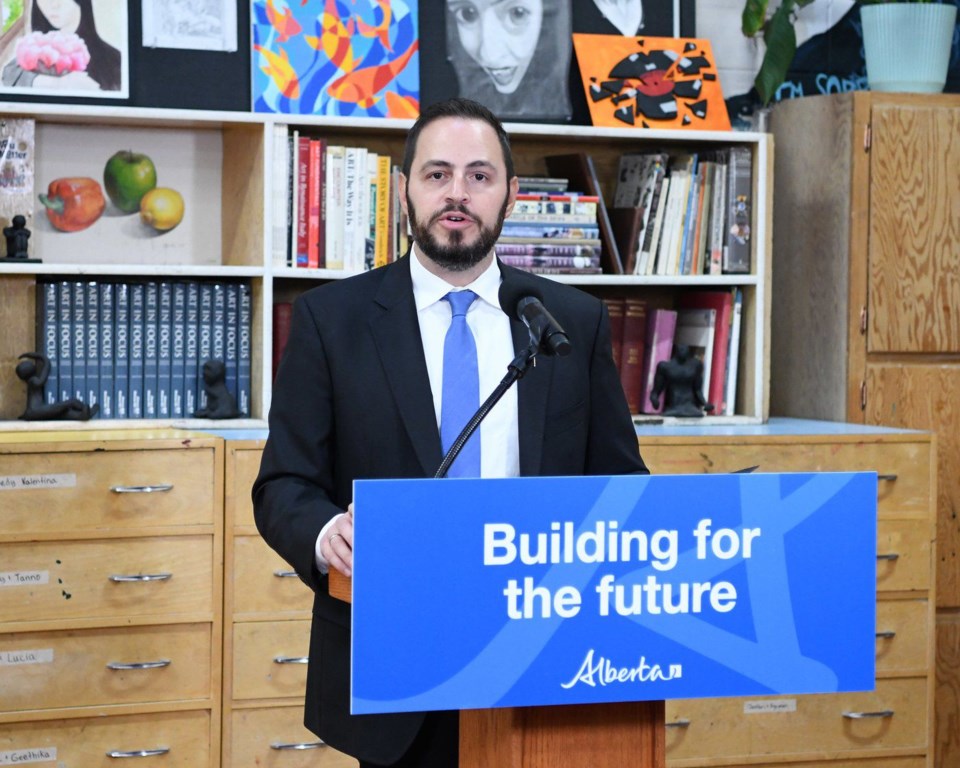Projects in six non-city communities have landed on an early funding list under a multi-billion-dollar program to alleviate overcrowding in Alberta schools.
Modernizations, replacement schools and even a demolition are on the list released by Alberta Education, as the province moves forward on a program projected to create or modernize 200,000 student spaces in seven years.
Alberta Education Minister Demetrios Nicolaides said approvals in smaller centres will likely continue to qualify for fast-tracking under the $8.6-billion School Construction Accelerator Program, announced by the premier in a Sept. 17 televised address.
The need for more and improved student spaces stretches across the province, Nicolaides told The Macleod Gazette. Beyond the obvious targets of Calgary and Edmonton, he pointed to Fort McMurray, Grande Prairie, Medicine Hat and Lethbridge as likely candidates.
“I think it’s a fair bet to say we’ll see some new schools coming to those communities,” he said. “And I would suggest we’ll see new schools coming to smaller communities in rural Alberta.”
The program — which more than triples previously announced spending of $2.1 billion — estimates 30 new schools and eight modernizations and replacements approved every year for three years. Along with 50,000 spaces previously approved, the program jumpstarts more than 100,000 new student spaces, more than 16,600 modernized spaces, and more than 20,000 spaces in new or relocated modular classrooms. Also envisioned are 12,500 new student spaces for public charter schools.
The government immediately announced 10 qualifying approvals in the three categories of construction, design and planning. All six construction approvals are for places beyond the Edmonton-Calgary corridor:
· Wainwright. This central Alberta town of about 6,600 people will see its Wainwright School replaced. Situated about 200 km southeast of Edmonton near the Saskatchewan border, Wainwright is part of Buffalo Trail Public Schools.
· Maillaig. Also up for a school replacement is this hamlet 200 km northeast of Edmonton. Maillaig (pop. 210), within St. Paul Education’s jurisdiction, is in the construction pipeline for the replacement of École Mallaig School.
· Redcliff. Parkside Junior High School will be modernized and expanded in Redcliff, a town of about 5,600 people just northeast of Medicine Hat along Highway 1 in southern Alberta. Redcliff is part of Prairie Rose Public Schools.
· Taber. In the southeast corner of Alberta, about 50 km east of Lethbridge, this town of about 9,700 people has two projects on the fast-track construction list — modernizations of W.R. Myers and D.A. Ferguson schools. Taber is in the Horizon School Division.
· Breton. The province announced two projects for this village of about 600 people, located 95 km southwest of Edmonton. The community within Wild Rose School Division will see the modernization of its high school and the demolition of its elementary school.
· Barrhead. Modernization lies ahead for Barrhead Composite High School, in this town of about 4,300 people. Barrhead is located 120 km northwest of Edmonton in Pembina Hills School Division.
Because older and smaller communities tend to have the greatest need for repairs and upgrades, modernization dollars beyond the six-community announcement are probably on the way, the minister said.
“So I think we'll get a good balance,” said Nicolaides, the member for Calgary-Bow. “Our main criteria are going to be enrolment pressure and utilization rates. We want to make sure that we're building schools where they're needed the most.”
Asked why the province did not recognize the need sooner, Nicolaides said, “The pressure that we're seeing in our schools has really occurred quite quickly and quite suddenly.”
He noted population growth in Alberta reached more than 200,000 people in 2023, an influx widely considered unprecedented in the province’s history.
Nicolaides used Calgary School Division to emphasize his point. In the 2022-23 school year, the overall school space utilization rate there was 87 per cent, a “comfortable level.” One year later, the rate had jumped up to 92 per cent.
“What we've seen happen has been a really sudden and significant increase in population and in student enrollment,” the minister said. “So we spent time over the spring and summer looking at ways in which we would be able to deal with this growth and develop this plan so that we can build schools as quickly as possible.”
Amanda Chapman, education critic for the NDP, said the spending is welcome and necessary. But the UCP should have seen a crisis unfolding and acted sooner, she said.
“Albertans have known for a long time we've been running into a serious problem with capacity,” said Chapman, the member for Calgary-Beddington. “Parents knew it, teachers knew it, students knew it, school boards knew it, and they have all been telling this government for three years, really, that we are running into a crisis point with physical space in schools and with actual learning spaces in schools.”
The shadow minister said the government should have started the program sooner and been more strategic. “When you announce a pot of money this big, it can cause issues.”
Chapman pointed to labour and skilled tradespeople shortages, and to inflationary pressures on materials. “This government choosing to wait to act until we have reached this crisis point has not made the situation better right now.”
Nicolaides said Alberta Education is working closely with Alberta Infrastructure to properly phase the growth. The number of 30 schools a year came out of meetings between the departments.
“I think we can all agree it's very important that we put a program together that is realistic,” he said. “The last thing we want is to announce a large number of schools and then not be able to actually build those schools.”
Added Nicolaides: “Our population growth is also a strong signal that Alberta is affordable, has good job opportunities and has an amazing quality of life, and the development of all of these schools will help ensure that remains the case.”



.jpg;w=120;h=80;mode=crop)
